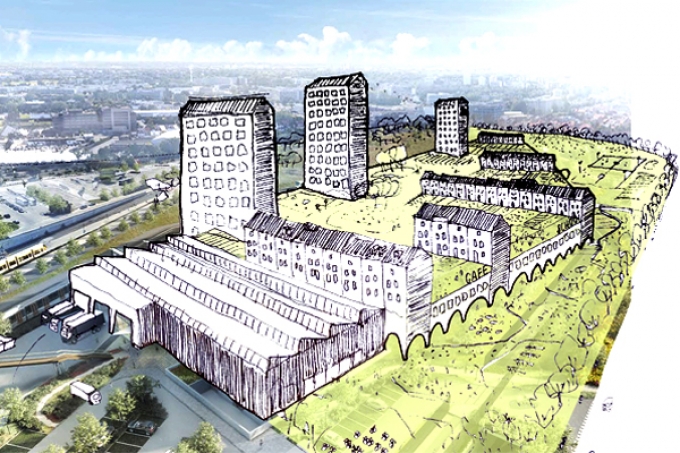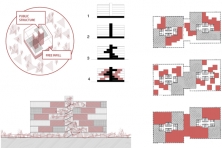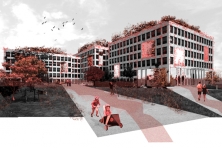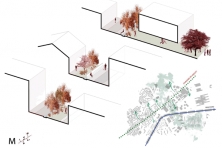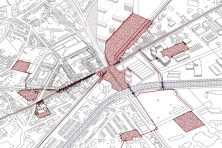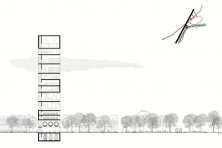Intensifying Productivity
Workshop Brussels (BE) - Workshop Site 2
PARTICIPANTS:
Pietro Colonna (IT), Enrico Zetti (IT), Maureen Soupe (CH), Winner in Alta (NO) with "Tanca"
Guobin Shen (DE), Kilian Juraschitz (DE), Winner in Aschaffenburg (DE) with "Wohnterrassen am Schillereck"
Radostina Radulova-Stahmer (DE), Prisca Hirstein (DE), Winner in Graz (AT) with "Unfolding the Fan"
Nea Tuominen (FI), Rachel Murray (NZ), Winner in Helsinki (FI) with "Lateral Coalescence"
Vilma Autio (FI), Winner in Tornio-Haparenda (FI/SE) with "Two Cities, One Heart"
Humberto Perreira (PT), Winner in Tubize (BE) with "Seed structure - the Production of Happiness"
Mircea Munteanu (BE), Runner-up in Amsterdam H-Buurt (NL) with "Buurtmakers"
Michele Angelo Vallicelli (IT), Annalisa Pilati (IT), Runner-up in Amsterdam Piarcoplein (NL) with "Urban Platform"
Maria Del Olmo Gomez (ES), Bernat Bastardas Llabot (ES), Runner-up in Amsterdam Transformatorweg (NL) with "Embracing Technology"
Airam Eloende Gonzalez Dorta (ES), Runner-up in Linz (AT) with "PROLinz Production Unlimited"
Diego Martín Sánchez (ES), Noemí Gómez Lobo (ES), Runner-up in Madrid (ES) with "Common Ground"
Andrea Giemeno (ES), Luis Juan Liñan (ES) Runner-up in Warszawa (PL) with "The Excity"
Bérengère Chauffete (FR), Special Mention in Trelleborg (SE) with "Future Comes Slowly"
Coach: Carlos Arroyo (ES)
Guest critics: Ann de Cannière, Ben Dirickx and Tania Vandenbroucke from Brussels Bouwmeester Chief Architect
SITE 2 - EVERE, BORDET - CHAUSSÉE D'HAECHT
TECH BOULEVARD
The area Chaussée d’Haecht-Bordet, located in the North-Eastern part of the city, is a real functional mixture inherited from successive layers of urbanization. The site suffers from a lack of coherence and spatial quality between these different functional and housing zones, and from a lack of identity, public spaces, equipments and attractivity. In other words, the urban character is missing.
The productive feature is characterized by an mix of production, offices and wide commercial areas. The site is also impacted by the presence of the North Atlantic Treaty Organization, and the Belgian Army, which, when they moved out, left a wide wasteland of 90ha that needs to be reprogrammed. However, between this atypical urban landscape, there is the “village” of Evere, composed of small housing ilots which barely succeeds in building a proper identity in this context of concrete mutation, and in connecting itself to the neighbouring productive activities.
On top of that context, there is also the creation of the new metro station Bordet linking this zone to the city centre.
Three main questions are raised:
1- DA VINCI: What urban context for the area Da Vinci composed of various activities and industrial parcels? How to find a proper coherence between all industrial parcels, and to link them to their environment and mostly to the new metro station Bordet?
2- Chaussée d’Haecht: How to redesign the unused 90ha? How to plan and reprogram this area to bring back mixity? How to conceive an urban and coherent vision integrating future projects and opening up the site to the landscape and to the existing infrastructures?
3- Village of Evere: What can be protected at the patrimonial level? What type of mixity does the site need? What type of urbanization should be implemented? How to integrate this municipality, located in-between two highly industrialized areas, to the urban context using the connection to the metro station Bordet?
Tech Boulevard studies a nodal point along the boulevard that links Brussels centre and the airport, with the potential of becoming a technology hub.
The area has developed historically along the infrastructures of the day, which generated specific urban structures for each moment in time.
- The old horse-and-cart road connecting Brussels to Haecht structured first the small scale closed urban blocks and later produced the strip development hosting activities of a variety of types and scales.
- The railway created a sharp division along its trajectory but also a new center of gravity around Bordet station.
- The highway-like boulevard brought about the typical car-centric development of the XXth century with sprawling business parks, social housing districts and the NATO headquarters.
Each new line implied the segmentation of the area into different morphologies, each with different developments in height.
All these specific urban structures come together around the Bordet railway station and the future metro terminal, but despite the diversity of functions hosted in each urban structure they are segregated in quasi monofunctional patches that don't interact with each other. A toolbox of potential mixities reveals various possibilities for stacking new (circled in red) and existing functions.
The ambition of this vision is to capitalize on the existing diversity, break the mono functionality by means of new linkages, hybridized densification strategies and addition of strategic new functions to create a veritable productive urbanity.
Intensifying Productivity
Download the PDF here
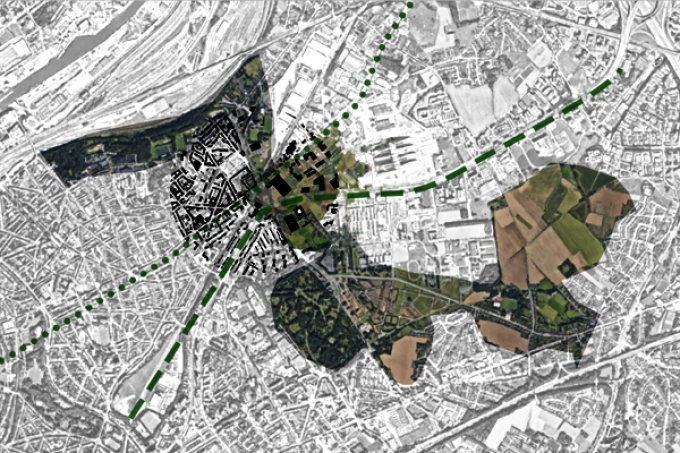
Urban industry
Conceptually, the existing obsolete office buildings on the plot are seen as an architectural resource or as “hardware”, waiting for new productive activities, or the “software”, to be hosted.
In the interior, with the purpose of promoting synergies among users, the core of each building is the only element redesigned, enlarging the circulation space with common areas in which interaction happens. In contrast, the different productive activities are spread in plan in many possible different configurations.
Regarding the exterior, the outdoor space previously seen as a leftover, is now what links the abandoned buildings to the new boulevard through the green spaces. In addition, productive activities associated with the greenery get into the interior of the former buildings through the cores, relating both the old and the new realms.
Evere
Alongside the same Chausée de Haech that runs parallel to the monofunctional office area is the center of the municipality of Evere. Here, we find a similar programmatic hermeticism, this time in relation to the predominance of housing and the lack of productive and commercial activities.
It is interesting to note, however, that this area has already integrated some small-scale industrial activities inside the city blocks, laying bare a possible integration of productive uses following the dictates of the existing fabric. Taking advantage of the urban pressure brought about by the future metro station, such a type of hybridization could be intensified according to three main strategies. First, by making visible the existing productive activities; second, by favoring the implementation of new small-scale productive pockets within the existing blocks; and, finally, by filling some of the existing gaps in these blocks with other typologies that enable the emergence of other kind of productive activities more related to the knowledge industry.
Download the PDF here
See other projects on the same site:
See the other sites:
